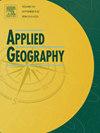Comparing methods for measuring park access and equity using US census microdata in metropolitan Miami
IF 4
2区 地球科学
Q1 GEOGRAPHY
引用次数: 0
Abstract
Knowledge from prior park equity studies has been limited by differences in the spatial analytic techniques applied to measure park accessibility, a lack of systematic methods comparisons, and overreliance on aggregated spatial data. Our study addresses these issues using individual-level, restricted-access US Census American Community Survey microdata (n = 339,000) from 2015 to 2019 to compare (a) alternative techniques for measuring access to park space and (b) how those measurement techniques affect inferences regarding patterns of inequity. It applies spatial analytic techniques to generate four park area per capita measures—one gold standard measure at the census block level and three widely-used measures at the census tract level in metropolitan Miami, USA—and compares the four methods using multiple analyses. The four methods generate somewhat dissimilar park accessibility values for individual residents. Bivariate analyses indicate that racially/ethnically minoritized or lower socioeconomic status people have less park accessibility than people from more advantaged groups, no matter the measure used. Multivariable models for each park accessibility measure yield largely dissimilar results regarding associations with social indicators, with consistent results for only two social indicators: Hispanic/Latino and older (>64 years) people have less park area per capita relative to non-Hispanic White and middle-aged (18–64 years) people, respectively. Findings suggest that advanced, fine-scale spatial analytic techniques should be applied to accurately characterize park accessibility for academic research and decision-making about parks. Findings also highlight the need to increase park space access for marginalized groups in metropolitan Miami.
比较使用美国人口普查微数据在迈阿密市区测量公园进出和公平的方法
由于用于衡量公园可达性的空间分析技术存在差异,缺乏系统的方法比较,以及过度依赖汇总的空间数据,先前的公园公平研究的知识受到限制。我们的研究利用2015年至2019年个人层面、限制访问的美国人口普查美国社区调查微数据(n = 339,000)来解决这些问题,以比较(a)测量公园空间可达性的替代技术和(b)这些测量技术如何影响有关不平等模式的推论。本文运用空间分析技术生成了四种人均公园面积测量方法——一种是人口普查区水平的黄金标准测量方法,三种是美国迈阿密大都市普查区水平的广泛使用的测量方法——并使用多重分析对四种方法进行了比较。这四种方法产生的公园可达性值对于个体居民来说有些不同。双变量分析表明,无论采用何种衡量标准,少数族裔或社会经济地位较低的人群的公园可达性都低于优势群体。每个公园可达性测量的多变量模型在与社会指标的关联方面产生了很大不同的结果,只有两个社会指标的结果是一致的:西班牙裔/拉丁裔和老年人(64岁)的人均公园面积分别低于非西班牙裔白人和中年人(18-64岁)。研究结果表明,应采用先进的、精细尺度的空间分析技术来准确表征公园可达性,为公园的学术研究和决策提供依据。调查结果还强调,需要为迈阿密大都会的边缘群体增加公园空间。
本文章由计算机程序翻译,如有差异,请以英文原文为准。
求助全文
约1分钟内获得全文
求助全文
来源期刊

Applied Geography
GEOGRAPHY-
CiteScore
8.00
自引率
2.00%
发文量
134
期刊介绍:
Applied Geography is a journal devoted to the publication of research which utilizes geographic approaches (human, physical, nature-society and GIScience) to resolve human problems that have a spatial dimension. These problems may be related to the assessment, management and allocation of the world physical and/or human resources. The underlying rationale of the journal is that only through a clear understanding of the relevant societal, physical, and coupled natural-humans systems can we resolve such problems. Papers are invited on any theme involving the application of geographical theory and methodology in the resolution of human problems.
 求助内容:
求助内容: 应助结果提醒方式:
应助结果提醒方式:


